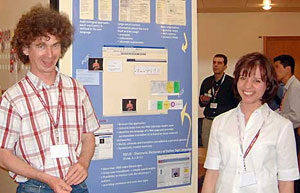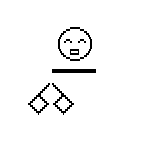Preface
On behalf of the program committee for the LREC
2004 "Workshop on the Processing of Sign
Languages", we are pleased to present you
with the proceedings which contain the papers
accepted for presentation at the Lisbon meeting
on May 30th, 2004.
This volume, full of eye-catching signs, symbols,
robots and screen-shots may charmingly attract
readers who, although having a sound knowledge
of Natural Language Processing, might be confused
by the great variety of topics and approaches.
How do SignWriting, avatars, XML, videos and
image recognition fit together? Are they competitive
approaches or different solutions to different
problems? Where will future research lead us,
which endeavours answer real social needs and
which scenarios are still illusionary - or congenially
visionary?
As always, the answers to these questions lie
between slow and quick, up and down, straight
and curbed. It is by drawing analogies to the
processing of spoken languages that we might
better understand the contribution and benefits
of the different approaches, span the space
of possible research and identify future tendencies
in the research on the processing of sign languages.
Trivially speaking, spoken languages are spoken
and heard. Sign languages are signed and seen.
Spoken languages have been written on stone,
wood, paper and electronic media. The technical
support ranged from a chisel to a keyboard.
The writing systems which developed have been
under the influence of the particular language
and the technical support. Having a hammer in
your right and a chisel in the left makes it
difficult to write from left to right. Having
stable vowels motivates their representation
in the written form. So how can sign languages
be written for love letters, poems, verdicts
and recipes?
One possible answer is SignWriting. SignWriting
does not decompose a sign into phonemes, syllables
or morphemes but body-parts, movements and face
expressions and assigns a representation to
each of them. Given such representations - e.g.
an alphabet for potentially all sign languages
-how may a keyboard, the input system, look
like? How are the simple elements (body-parts,
movements and face expressions) to be encoded
in the computer and how the composed signs?
As pictures, in Unicode or XML? How will this
influence the input of signs, the layout and
formatting of SignWriting documents, the possibilities
to perform fuzzy matches on texts, in dictionaries,
in the Internet? The papers written by Richard
Gleaves, Valerie Sutton (SignWriter), Antônio
Carlos da Rocha Costa, Graçaliz Pereira
Dimuro, Juliano Baldez de Freitas (A Sign Matching
Technique to Support Searches in Sign Language
Texts), Angel Herrero (A Practical Writing System
for Sign Languages), Steven Aerts, Bart Braem,
Katrien Van Mulders, Kristof De Weerdt (Searching
SignWriting Signs), Daniel Thomas Ulrich Noelpp
(Development of a new 'SignWriter' Program)
discuss these and related questions.
SignWriting, however, is by no means the only
possible way of writing signs. Thomas Hanke
in his invited talk “HamNoSys –
Representing Sign Language Data in Language
Resources and Language Processing Contexts”
introduces an alternative approach, the Hamburg
Notation System for Sign Languages. The purpose
of HamNoSys has never been a usage in everyday
communication. It was designed to comply with
research requirements, e.g. for corpus annotation,
sign generation, machine translation and dictionary
construction. It thus differs from SignWriting
in its scope and granularity. Unicode and XML
solutions are available for HamNoSys, c.f. Ralph
Elliott, John Glauert, Vince Jennings and Richard
Kennaway in their contribution “An Overview
of the SiGML Notation and SiGMLSigning Software
System”.
Once these fundamental questions regarding the
writing of sign languages will be settled, derived
notions such as word n-grams and character n-grams,
important for computational approaches, may
be used for applications such as language recognition,
document classification and information retrieval.
Spelling checking, syntax checking and parsing
are obvious further developments once these
more fundamental questions about the writing
of signs will have been agreed upon.
It is a matter of fact, however, that most signers
have not been trained in reading or writing
in SignWriting. What is known as “text-to-speech”
in the processing of spoken languages would
seem a possible solution: a front-end to web-pages,
mail boxes etc. would sign out the written text.
As shown by Maria Papadogiorgaki, Nikos Grammalidis,
Nikos Sarris, Michael G. Strintzis in “Synthesis
of virtual Reality Animations from SWML using
MPEG-4 Body Animation Parameters” and
Yiqiang Chen, Wen Gao, Changshui Yang, Dalong
Jiang and Cunbao Ge in “Chinese Sign Language
Synthesis and Its Applications”, avatars,
i.e. virtual signers, may be constructed which
translate a written form of a sign language
or spoken language into signs, just like translating
"d" into the corresponding sound wave.
A front-end on the input side of the system
might translate signs into a written representation.
Speech Recognition becomes Sign Recognition.
Two different techniques are introduced. The
recognition with the help of a data glove precedes
from the signer's perspective and his/her articulations,
c.f. Jose L. Hernandez-Rebollar’s contribution
“Phonetic Model for Automatic Recognition
of Hand Gestures”. This approach may seem
in line with the definition of phonemes in terms
of their articulation and not their acoustic
properties. On the other hand, it does not match
our every-day experience in which we use a microphone
and not electronic contact points at our vocal
cords, tongue, velum, teeth and lips when using
a telephone. The recognition of signs with the
help of cameras, the second alternative, leads
to the description of signs from the observer's
point of view, in terms of formants and f0,
so to say. However, the articulation can be
reconstructed and might be a better representation
for the signs than the ‘phonetic’
description, as suggested by Boris Lenseigne,
Frédérik Gianni, and Patrice Dalle
in “A New Gesture Representation for Sign
Language Analysis”.
Both modules, sign recognition and sign generation,
may serve MT systems with a sign language as
source or target language respectively. A sign
language as target language is used in translation
experiments described by Jan Bungeroth and Hermann
Ney in “Statistical Sign Language Translation”.
This corpus-based approach to Machine Translation,
by the way, raises the question of sign language
corpora. The only paper which really tackles
the question of signed corpora in this collection
is that of Onno Crasborn, Els van der Kooij,
Daan Broeder, Hennie Brugman “Sharing
sing language corpora online. Proposals for
transcription and metadata”. Matt Huenerfauth
in his contribution “Spatial Representations
for Generating Classifiers Predicates in an
English to American Sign Language Machine Translation
System”, focuses on a particularly difficult
aspect of sign language generation, the classifier
predicates. Thus, when signing "leaves
are falling", it is not enough to generate
the sign "leave" and "falling",
e.g. a downward movement. Instead the hand shape
of "falling" should indicate the kind
of object that is falling, e.g. with a flat
hand.
The usage of classifiers leads us directly to
the question of how to construct dictionaries
for sign languages. Learners' dictionaries,
reference dictionaries, dictionaries of NLP
applications all need information about part
of speech, lexical functions, idioms, subcategorization
and semantics, which by no means is the same
as in the national spoken language. How do we
search in a sign language dictionary? Have you
ever looked up a Chinese or Japanese Dictionary?
Paola Laterza and Claudio Baj in their paper
“Progetto e-LIS@” propose an at
least partially equivalent approach to the ordering
of signs in a sign language dictionary. How
do you present the dictionary content to a learner?
In the national spoken language or in SignWriting?
The complexity of the question can be gauged
from Elana Ochse’s contribution “A
Language via Two Others, Learning English through
LIS”. Should we use videos, photos, animations
or drawings to represent the entries in dictionaries?
A number of authors discuss these and related
topics in the context of specific dictionary
projects: for static presentations, i.e. paper
dictionaries, Inge Zwitserlood and Doeko Hekstra
propose the “Sign Printing System –
SignPS” to compose pictures of signs.
Eleni Efthimiou, Anna Vacalopoulou, Stavroula-Evita
Ftinea, Gregory Steinhauer focus in their paper
“Multipurpose Design and Creation of GSL
Dictionaries” on the content, i.e. the
types of information to be included in a sign
language dictionary. Chiara Vettori, Oliver
Streiter and Judith Knapp focus on different
user requirements and the possible role of SignWriting
in a sign language dictionary. Rubén
Nogueira, Jose M. Martínez and present
a dictionary project of a particular kind: “19th
Century Signs in the Online Spanish Sign Language
Library: the Historical Dictionary Project.”
Ingvild Roald finally gives a practical account
on the history of techniques for the creation
of sign language dictionaries, discussing advantages
and drawbacks of the respective approaches.
When writing these lines, the preparation of
the workshop and the proceedings is almost finished.
This workshop wouldn’t have been possible
without the energy many people have invested
in their spare time. First of all we would like
to thank the authors who have done their best
and provided superb papers. Our thank goes also
to the reviewers for their detailed and inspiring
reviews. Last but not least we want to thank
Sara Goggi who accompanied the workshop on behalf
of the LREC Programme Committee.
In closing we would like to thank you for attending
the workshop, and we wish you will have a great
time.
Oliver Streiter
ostreiter@eurac.edu
Antônio Carlos da Rocha Costa
rocha@ATLAS.UCPEL.TCHE.BR
April 22, 2004 |
















